When fine lines develop around the forehead, crow’s feet around the eyes and wrinkles around the mouth, it is a sign of aging that is more obvious than a change in hair colour and density or a change in body posture.
Skin, consisting of bonded layers, begins to sag and become lumpy as a person ages. What is basically happening is that the skin loses its elasticity. This is usually a result of a depletion of three proteins common in skin: collagen, elastin, and hyaluronic acid.
Collagen is a fibrous protein found in skin, bone, cartilage, muscles, and tendons. It works to connect body tissue. It makes up 25 percent of the protein in the human body, and it is even found in teeth. Like a glue, it holds the tissues of the body together, including the layers of the skin.
Elastin is a protein that pulls back the skin when it is stretched. In addition to keeping the skin elastic and flexible, it keeps the skin smooth. This is why your mouth returns back to its normal shape after using the muscles of your face when talking.
The third essential protein for a youthful, healthy skin is hyaluronic acid. The more of this protein that is lost, the more aged a person begins to look. Fortunately, apart from cosmetics, it is also possible to take nutritional supplements to restore levels of hyaluronic acid. Moisture is lost because of lower amounts of hyaluronic acid. Diets rich in kelp, seaweed, and fish help maintain hyaluronic acid. People with Mediterranean or Asian diets appear to age slower with “plumper skin” than those people who live in cultures where refined foods filled with additives have become the norm. In cultures with poor diets, an enzyme called hyaluronidase begins to work against hyaluronic acid. Part of the process of restoring hyaluronic acid is to reduce the hyaluronidase enzyme.
Depletion of these three skin proteins is exacerbated by indulging in poor health habits like smoking, drinking alcohol, not drinking enough water, not eating nutritious food, not exercising, and getting an excessive sunburn. While taking care of your health by reversing all these conditions will go a long way to restoring your youthful appearance, you can also get relatively quick results by using lotions that provide the skin with what it needs to maintain its elasticity. Most anti-aging skin care programs work on restoring collagen, elastin, and hyaluronic acid.










